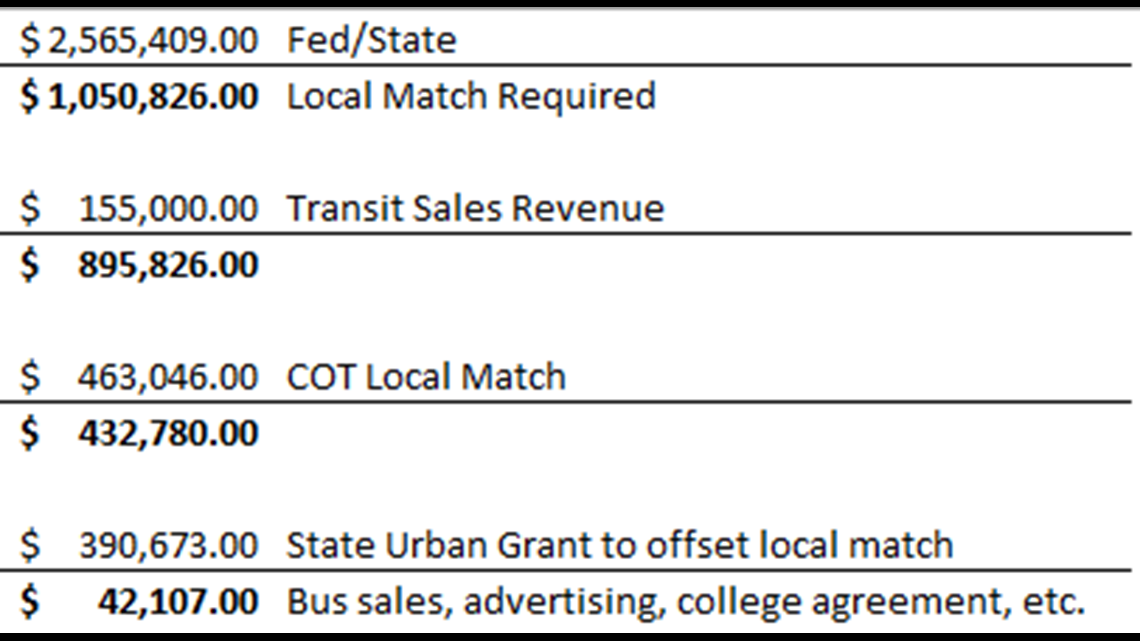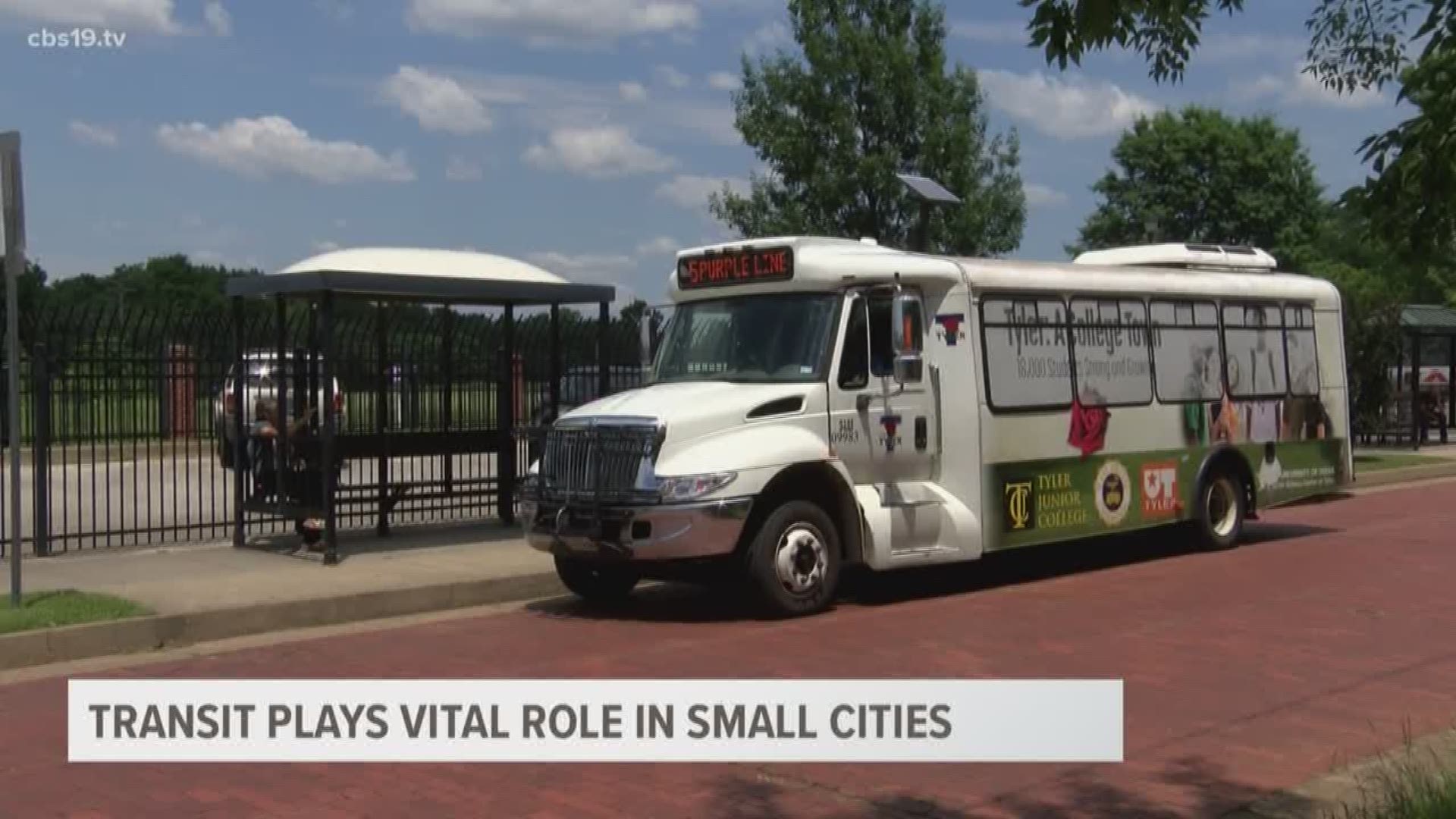TYLER, Texas — Some form of public transportation is vital in all cities, both small and large. It is what propels those cities forward, while also helping some of its citizens find and keep jobs, not to mention spurs economic growth.
Just like many small cities with 100,000 to 500,000 people living in them, Tyler's public transit system has seen its ups and downs.
Although there are issues, the city has seen an increase of 4% in its ridership over the last two years. According to the most recent data available, in 2018, the city had 34,590 riders. This fiscal year, the city has 36,102 riders on its fixed route.
After becoming unemployed, Ron Brunelle, 60, of Tyler utilizes the city of Tyler bus system on occasion throughout the week.
"Thank the Lord I have transit so I can get around," Brunelle said, in regards to the city's bus system.
In search of jobs and to run weekly errands, Ron is one of dozens who use public transit on a daily basis, just like Abraham Gonzalez.
"They think not a lot of people ride the bus, we do," Gonzalez said.
Gonzalez has lived in Tyler for the last three years. He uses public transit to get back and forth to work every day.
"This is good [bus system], but I think it could be better," Gonzalez added. "Sometimes we are waiting for a long time at the bus stop."
Gonzalez says more bus drivers and additional buses would be a great addition to the bus system to decrease current wait times.
"If they could get more bus drivers or mini-buses it would be great, especially during peak hours, like right now, I have been waiting for 35 minutes," he added.
On time departures and more buses during peak hours are just a couple of the issues both Gonzalez and Brunelle say need to be addressed.
According to Robert Gil, the city of Tyler Transit department's General Manager, on average, the Tyler Bus System makes about 500 trips across the city every day. Another 180 to 200 scheduled trips are made daily on the city's public Paratransit service as well.
One group working to ensure everyone has access to reliable, accessible and affordable transportation is the East Texas Human Needs Network.
"We're working to strengthen programs to build connection and to make sure that people are aware of the human services that are in our community," Founder of the East Texas Human Needs Network (ETHNN), Christina Fulsom, said.
"We want to increase ridership," Fulsom added. "If we can increase ridership, then some of the other changes that need to take place, they'll be able to do, but you can't do one without the other."
In 2016, the organization conducted a Comprehensive Community Needs Assessment to understand the nature, extent, and effects of poverty on people living in East Texas.
More than 250 households in Smith County and results from just over 700 people were included in the assessment. One area of study was transportation. In that area, the organization found 31% of those surveyed did not have access to a vehicle. Thus coming to the conclusion that there are several factors, including transportation that, "affects all aspects of life and limits people's ability to live fruitful and happy lives."
"It was important for us," Fulsom added. "If we can't provide cars for people, how do we get them to utilize the system that is in place?"
After their findings were released, ETHNN has been working with several groups to address the growing need for reliable transportation.
"We've been working with [Tyler] city transit, with Go Bus, The East Texas Council of Governments, with NDMJ, lots of organizations," Fulsom added. "We're working together to ensure that people are aware of the services, that they learn how to use those services, and ultimately be able to get to work to get their education and healthcare."
While ETHNN continues to work with those groups to address concerns, public transit in small cities can sometimes be a difficult issue to solve, especially when it comes to lack of funding and resources.
"We don't make enough money on the local level to actually support the system," Gil said. "So, we utilize the grants that are out there from the Federal Transit Administration to help subsidize what we actually do here in the city."
That means the city gets most of its funding from federal and state resources. A breakdown of the city's most recent budget can be viewed below.


Less than $200,000 actually come from local fares. One of the reasons for such a low return on investment. The city wants to keep the fares at an affordable, low rate. You can find a list of the price you'll pay to ride the bus here.
With budget constraints in mind, how does one address some of the issues its riders have voiced?
"Due to the nature of what happens here throughout the day, we all know that we have a 100,000 population, but it jumps up to 200,000 during the day," Gil added. "So that causes more traffic for our buses to have to go through and with that being said, sometimes we do fall behind. So in regard to the law, it requires we put a second bus or more operations into the city so we can make it work. Our goal is to not leave anyone behind."
Plans to fix the problem:
In addition to working directly with customers who report issues, the City of Tyler Transit Department says they are taking steps to get the system moving in the right direction.
"These issues are old," Gil said. "The last route study that was completed 11 years ago is not comparable to what we have today in the development of the city to the South."
With that in mind, in anticipation of what will likely be drastic growth numbers in the upcoming Census, the city of Tyler is in the preliminary stages of conducting its own comprehensive route study to determine what is next for the transportation department. However, they are not losing sight of the current issues they have with the system.
Gil says to accommodate riders during peak hours, "we ensure that we have larger buses during peak hours."
Peak hours are considered your 'morning rush', midday and riders who typically work second-shift hours.
Once we learn more about the city of Tyler's upcoming route study, this story will be updated.
If you want to help find better solutions to public transportation issues across East Texas, please see the link below to learn more about the East Texas Human Needs Network's 2019 Comprehensive Community Needs Assessment.
Have other transportation concerns? Send me an email: tparker@cbs19.tv
Information about different forms of public transit in Tyler:
How to report an issue:
Find out more about the East Texas Human Needs Network:
Find out more about the East Texas Council of Governments:

